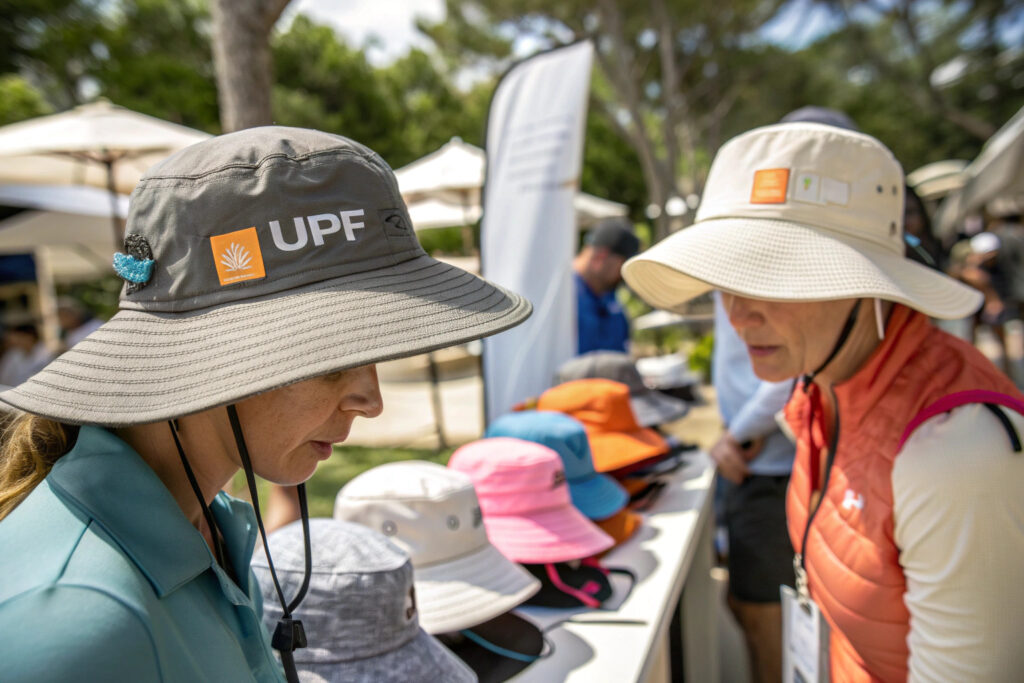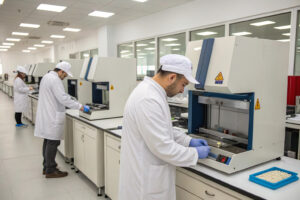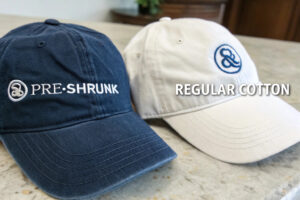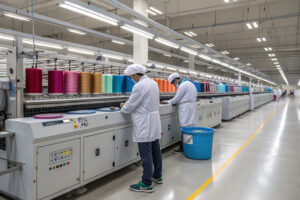Designing UPF-rated sun hats for outdoor retail requires balancing technical performance, consumer aesthetics, and commercial viability. With growing awareness of sun protection importance,Outdoor consumers now seek hats that are certified for sun protection and UV defense, while also embodying a harmonious blend of fashion and practicality.
The most successful UPF-rated sun hat designs combine appropriate material selection, strategic construction methods, verified testing protocols, along with features specifically designed for outdoor use, which not only meet the needs of outdoor enthusiasts but also achieve the necessary sun protection rating.
Understanding these design elements enables outdoor retailers to develop sun hat collections that genuinely protect customers while delivering the comfort, durability, and style expected in the outdoor market.
What Materials Deliver Reliable UPF Protection?
Material selection forms the foundation of UPF performance, with specific fabric properties determining the level of ultraviolet radiation blocking achievable in sun hat designs.
UPF-effective materials include tightly woven synthetics, specialized sun-protective fabrics, and naturally dense natural fibers that physically block or absorb harmful UV radiation before it reaches the skin.
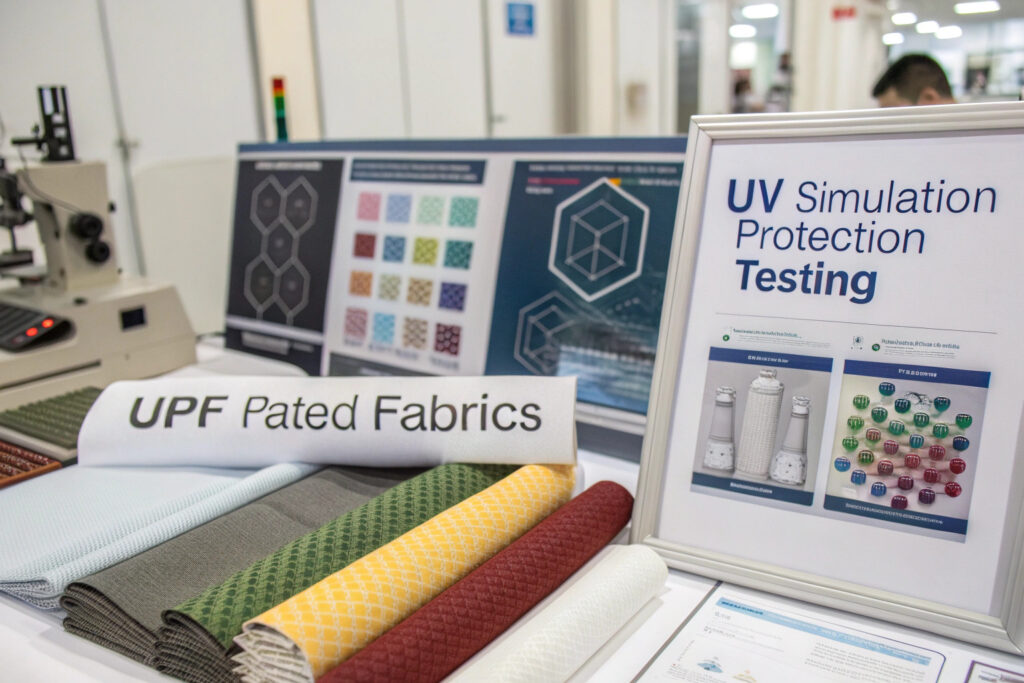
How Does Fabric Construction Impact UPF Ratings?
The physical structure of fabrics determines their inherent sun protection capabilities through fiber density and coverage.
Tightly woven fabrics with high thread counts create physical barriers that block UV penetration, typically achieving UPF 15-25 without chemical treatments. Microfiber polyester constructions utilize extremely fine filaments that create dense surfaces with UPF 30-50+ ratings. Double-weave techniques create fabric layers within single materials, enhancing protection without adding weight. Our material specifications require minimum 180 threads per inch for UPF 30+ ratings and 220+ threads per inch for UPF 50+ classifications.
What Role Do UPF-Enhancing Treatments Play?
Chemical treatments and specialized dyes can significantly increase the sun protection of otherwise moderate-performing fabrics.
UV-absorbing finishes containing benzotriazole compounds can boost UPF ratings by 15-25 points when applied to suitable base fabrics. Solution-dyed yarns with built-in UV inhibitors provide permanent protection that won't wash out, unlike surface applications. Ceramic particle infusions reflect UV radiation while maintaining fabric breathability. Our treated fabrics maintain UPF 50+ ratings through 20+ industrial wash cycles, ensuring long-term protection for outdoor consumers.
What Design Features Maximize Sun Protection?
Beyond material selection, specific design elements significantly impact the overall sun protection effectiveness of hats by addressing coverage gaps and exposure angles.
Strategic design features include brim dimensions, crown coverage, neck protection, and ventilation systems that work together to create comprehensive sun protection systems.
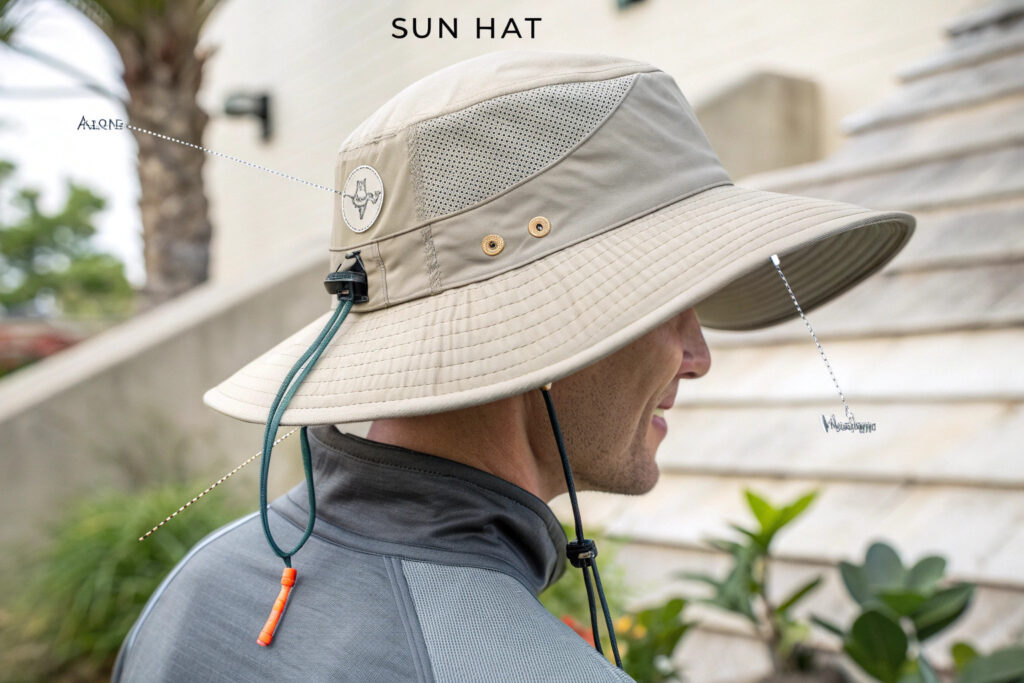
How Does Brim Width Affect Protection Level?
Brim dimensions directly determine facial and neck protection areas, with specific measurements providing defined protection zones.
3-inch brims provide basic face protection, blocking direct UV exposure to nose, cheeks, and chin. 4-5 inch brims extend coverage to neck and shoulders, areas particularly vulnerable during outdoor activities. 360-degree brim designs provide all-around protection regardless of sun angle or activity direction. Our design standards specify minimum 3.5-inch brims for UPF-rated hats, with 5-inch options recommended for extended outdoor exposure.
What Neck Protection Systems Work Best?
Neck protection represents a critical sun safety element often overlooked in standard hat designs, requiring specialized features for comprehensive coverage.
Integrated neck drapes with UPF-rated fabric provide permanent protection for the vulnerable posterior neck area. Detachable neck capes offer versatility for different activity levels and temperature conditions. Extended back brims create built-in neck shadows without additional fabric layers. Our neck protection systems maintain UPF 50+ ratings while incorporating mesh ventilation panels to prevent overheating.
How to Verify and Communicate UPF Ratings?
Credible UPF verification and clear consumer communication build trust and ensure outdoor customers understand the protection level they're purchasing.
Reliable UPF verification involves standardized testing, certification processes, and transparent labeling that accurately represents protection capabilities.

What Testing Standards Ensure Rating Accuracy?
Internationally recognized testing protocols provide consistent, comparable UPF data across different hat styles and materials.
AATCC Test Method 183 measures ultraviolet transmission through fabrics using spectrophotometric analysis, the global standard for UPF determination. AS/NZS 4399:1996 provides the Australian/New Zealand standard that many outdoor consumers recognize as particularly rigorous. UV-A and UV-B separate testing ensures protection across the full spectrum of harmful radiation. Our testing protocols exceed basic requirements by testing hats in both new condition and after 20 simulated washes to verify lasting protection.
How Should UPF Information Be Displayed?
Strategic labeling and communication ensure customers understand protection levels and proper usage.
Clear UPF rating tags prominently displayed on hat exteriors provide immediate visibility of protection level. Care instruction inclusion explains how to maintain UPF effectiveness through proper cleaning. Educational hangtags explaining UPF significance and comparison to SPF help consumers make informed decisions. Our labeling system uses color-coded tags (blue for UPF 30+, red for UPF 50+) that customers can quickly identify across different hat styles.
What Outdoor-Specific Features Enhance Functionality?
Outdoor sun hats require specialized features that address the unique demands of active use while maintaining sun protection integrity.
Features designed to enhance performance include a ventilation system, quick-drying technology, foldable storage options, and various secure-fitting choices—all of which elevate user comfort during extended outdoor activities.

How Do Ventilation Systems Maintain Comfort?
Strategic airflow management prevents overheating while maintaining sun protection coverage.
Crown ventilation mesh panels placed in non-critical protection areas enhance airflow without compromising UPF ratings. Laser-cut ventilation patterns create precise airflow channels in solid fabric areas. Airflow channel construction within hat crowns creates chimney effects that draw heat upward. Our ventilation systems improve air permeability by 40-60% while maintaining UPF 50+ ratings in critical coverage areas.
What Moisture Management Features Are Essential?
Sweat control and quick-dry capabilities ensure comfort and performance during high-exertion outdoor activities.
Moisture-wicking sweatbands pull perspiration away from the forehead, preventing dripping and eye irritation. Quick-dry fabric treatments ensure hats don't become heavy and uncomfortable when wet from sweat or water exposure. Antimicrobial treatments prevent odor buildup during multi-day outdoor trips. Our moisture management systems maintain comfort during continuous wear in temperatures up to 95°F (35°C), a critical threshold for outdoor usability.
How to Balance Protection with Packability?
Outdoor consumers need sun hats that provide reliable protection while remaining practical to pack and transport during adventures.
Packable sun hat designs maintain their protective shape and UPF ratings after compression, using strategic materials and construction methods.

What Materials Allow Compression Without Damage?
Specific fabric properties and treatments enable repeated packing without permanent deformation or protection compromise.
Memory fabrics with natural recovery properties return to original shape after compression, maintaining brim integrity and coverage. Crush-resistant brims using flexible plastics or molded foams withstand packing without permanent creasing. Wrinkle-resistant treatments prevent fabric distortion that could create gaps in UV protection. Our packable designs recover wearable shape within 30 minutes of unpacking and maintain UPF ratings through 50+ compression cycles.
What Construction Methods Enhance Packability?
Strategic engineering allows hats to compress significantly while maintaining protection effectiveness when worn.
Segmented brim construction with strategic joining points allows controlled folding along predetermined lines. Collapsible crown designs that flatten completely without damaging structural elements. Modular component systems where brims and crowns can be separated for packing and reassembled for wear. Our most packable designs compress to 20% of their worn volume while maintaining full UPF 50+ protection when deployed.
Conclusion
Designing UPF-rated sun hats for outdoor retail requires integrating material science, strategic design, verified testing, and outdoor-specific features that collectively create products offering genuine sun protection alongside practical functionality. The most successful designs balance technical performance with consumer needs for comfort, style, and packability.
By implementing these design principles and maintaining rigorous verification standards, outdoor retailers can develop sun hat collections that truly protect their customers while meeting the practical demands of outdoor adventures across various activities and environments.
Ready to develop UPF-rated sun hats for your outdoor retail business? Contact our Business Director Elaine today to discuss design strategies, material options, and certification processes. Her email is elaine@fumaoclothing.com. Let's create sun protection solutions that outdoor enthusiasts will trust and rely on for their adventures.
